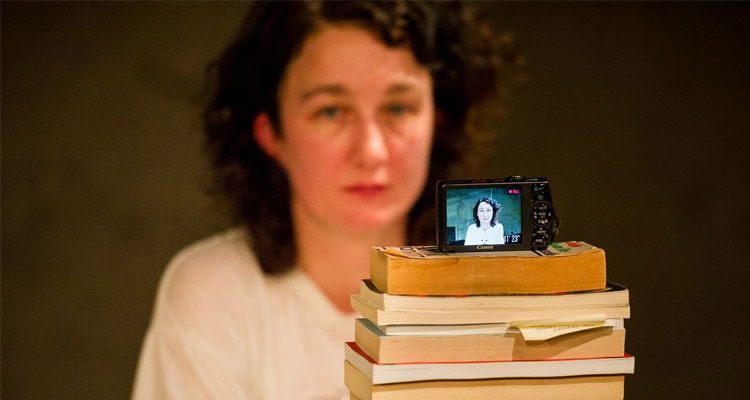“You’re talking a lot, but you’re not saying anything.” As sung by David Byrne in “Psycho Killer,” it’s a lyric that serves as a put-down at best, a condemnation from a deranged mind at worst. But as practiced by New York-based performer Jeanine Durning, it’s a compliment and a challenge. In her latest solo piece, “inging” (a reference to the suffix “ing”), Durning puts Byrne’s lyric to action by talking non-stop for nearly an hour. There’s no script to adhere to, and no pre-ordained topic or subject to cover. Durning just, well…talks. And keeps talking. And keeps talking. It’s a deceptively simple yet stunningly effective (and physical, and emotional) piece that alternates between funny and troubling, flippant and harrowing, moving and cathartic.
The Talking Heads, strangely enough, were just one of roughly 8,000 subjects that Durning referenced during Wednesday night’s performance at the Lynden Sculpture Garden, as part of Alverno Presents’ “Solo Flight” series. (Durning will perform “inging” again this Friday.) “Referenced” may be too strong a word: Durning didn’t so much as touch on subjects as she lightly grazed them, hitting upon a certain topic before quickly veering off into another. Amidst a sparsely appointed room and a crowd of two dozen, Durning began her piece by speaking about nothing in particular, noting how the concept of “now” was different for everyone. From there, she barreled ahead in a stream-of-consciousness, free-associating filibuster that included bits of philosophy, literature, politics, jokes, autobiography, pop-culture, and music. Public Enemy, The Wizard Of Oz, and an old Army recruitment song all made appearances in a typical 10-second span, with hardly a breath or pause in between. “It’s not about the quality of information, it’s about how much you have,” Durning said at one point, perhaps unconsciously summing up her own piece.
Indeed, “inging” wasn’t about the quality or content of the marathon speech; stripped of any and all filters between thought and expression, the physical act of speaking itself was the main attraction. Like a jazz musician, Durning riffed on her surroundings, occasionally dropped into repetitive grooves, and adjusted her trajectories when necessary. The few props included in the piece slyly served as counterpoints: a stack of books with a digital camera on top—its lens facing Durning, its view screen facing the audience—and a video projector showing a triad of past performances created a time-delayed feedback loop that played against Durning’s live, of-the-moment performance. “The thoughts are coming too quick,” she blurted out at another point, once again summing up her piece.
Still, as the performance wore on, Durning’s never-ending monologue grew more and more inward looking and emotionally fraught, often devolving into mere sounds and Tourette-like vocal tics. It also grew more physical; at one point, she took to the floor, wedging herself under the folding chair of an audience member. (Volcano Choir’s Jon Mueller, as it turned out.) She mounted a fireplace, stood on a chair, and mimed throwing a chair through the windows of the Lynden. All this while talking, talking, talking. Near the end, with her voice hitting a fever pitch and tears welling in her eyes, Durning seemed to be on the verge of a full-fledged emotional breakdown.
When Durning finally stopped (abruptly), the charge left in the room was impossible to ignore. After slowly turning off her camera and projector, she left the room. The audience sat quietly, suddenly alone. Durning’s sustained burst of language was gone, but its echo remained. Then that, too, disappeared, leaving the crowd adjusting to the night’s only logical conclusion: silence.

